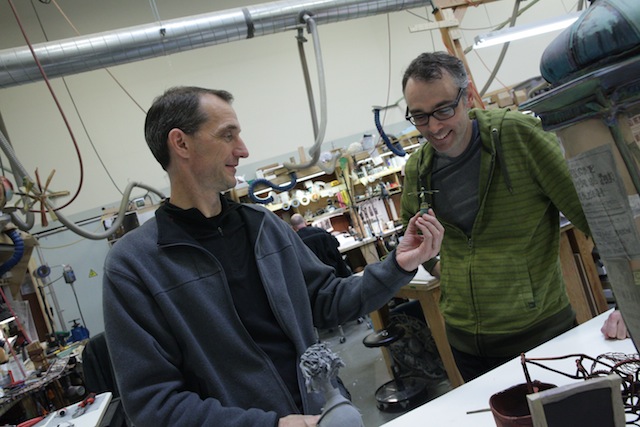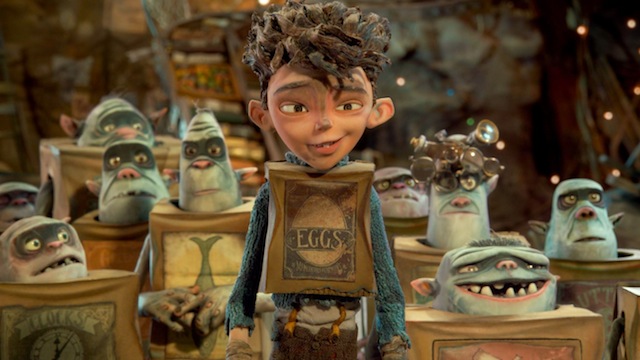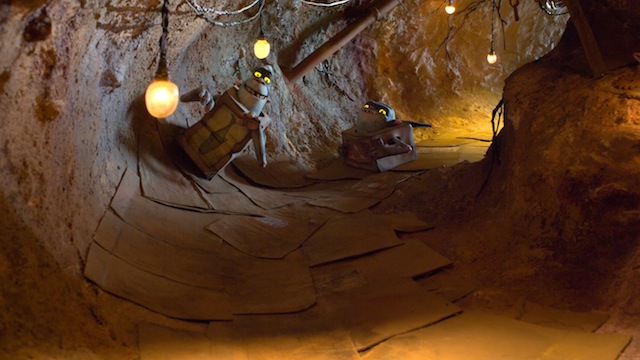Interview: Anthony Stacchi And Graham Annable, Directors Of 'The Boxtrolls'
By Staff in Arts & Entertainment on Sep 26, 2014 3:00PM

Anthony Stacchi And Graham Annabele, courtesy Focus Features.
We sat down with co-directors Anthony Stacchi and Graham Annable to discuss their directorial debut, The Boxtrolls. Both come from an artistic background in various film disciplines. Previously, Graham was storyboard artist on Paranorman but has been an animator and director for several video game productions. Stacchi has also been an animator on Antz, Aeon Flux and done visual effects on Hook, Ghost and Back to the Future.
CHICAGOIST: The Boxtrolls is a stop animation movie and not a normal live action movie. To make this kind of movie, it’s all about the details and the minutia to get it done. Did you come up with your ideas and then have to find a delegation process to provide the animators what you needed done? What was the process?
ANTHONY STACCHI: From the very beginning, every animated movie starts with a story reel and you work with the story department. Prior to that we worked on the script from the book. It’s a huge book with a cast of thousands and we had to boil that down to the core story. It was always a story about a boy raised underground and we loved the characters of the Boxtrolls. We knew it was a relationship we would work with. Snatcher the villain has changed quite a bit from the book but he’s still all there. We honed the story down so we could do a ninety minute movie.
Then we took that to storyboards. Graham and I were joined at the hip during that entire process of building the blueprint.
C: Is that both of you, the CEO of Laika and producers deciding at that point this is the movie before you take it to the team?
ANTHONY STACCHI: Yes, you never stop improving the story. Nothing is ever done in animation until you run out of time. It’s a race to the start and you go until you run out of time or money and you get better every step of the way.
For example, you do eight recording sessions with Sir Ben Kingsley. Even when you’re done doing it a number of times and you have it, you think maybe we could get a better version of this even if you’re in production. You plan that for the next time you get him in two weeks and hold production to see if it will work better. You’re constantly trying to get it better.
GRAHAM ANNABLE: This was my first time being in this role as the director and you do your best each time articulating how you want each part of the story to go and the context that needs to happen. We really had the philosophy of best idea wins. Who ever had it, wherever it came from, we stepped out of the way and worked with it. We let the departments do their thing.
C: So you’re saying you took your director egos out of it?
ANTHONY STACCHI: (laughter) This is true of every big Hollywood Director, if they’re smart and do good movies, ninety percent of the success is casting and then you have a lot of people working hard to make you look good. Unless you’re doing something wrong, they’re all working to make you look good and if you don’t get out of the way to let them, then it’s really stupid.

'The Boxtrolls,' courtesy Focus Features.
C: During eighteen months of filming, you said you were getting a few seconds a week from each animator?
ANTHONY STACCHI: There were 55 sets active.
GRAHAM ANNABLE: We had 30 animators, so that many pieces of film coming to us.
ANTHONY STACCHI: Sometimes less because they’re trying to determine how something walks or moves. It’s all up to our producer David. This week we get three minutes next week we need seven minutes. They watch that number and measure it very closely.
We would visit the animators every day and we’re able to see what they’ve been doing. As directors, we’re allowed a ten frame cut back to see where the shot was and make changes, if possible. It’s very difficult to take the puppet back further and know exactly where it was. If it’s a violent movement, it’s very easy to do. We were allowed ten frame cut backs, fifty frame cut backs but if you want twenty, whoa! Everything stops. The producer comes out. There’s a meeting because that is throwing the whole schedule off because that puppet is needed on another set in two days and the set you’re on needs to be torn up and they have another set built in that space to get those shots.
C: It struck me during the movie and as we talk now, seeing the animator at the end of The Boxtrolls in a flurry as the scene unfolds. You take care of the detail and give the characters so much personality just how many times Lord Portley-Rind rolls his mustache. That’s not something you just CGI animate. You had him rolling both sides of his mustache or one side.
ANTHONY STACCHI: (laughter) We were allowed to have a specific number of mustache rolls.
C: How long would it take to do one mustache roll?
GRAHAM ANNABLE: It’s a whole bizarre process because of how we do things at Laika. The mustache was created digitally and spit out on a 3D printer. It’s a very specific thing were the mustache itself rolls out but the animator has to articulate the puppet and the hand for each movement.
ANTHONY STACCHI: And you can’t reuse the mustache twirl because he’s saying different things each time and that’s why we were given a limited number of mustache twirls.
We would get resistance at certain times for different things. When Eggs is fighting snatcher on the mechadrill. His fingers go in to Snatchers mouth. We had to pre-figure out, where are the hands during the dialog and make the puppet’s mouth have gaps so the other puppets fingers would go in and have it work.
C: Did you ever find yourself angry with a character? I know they’re puppets but did they ever get you upset.
ANTHONY STACCHI: (Laughter) One of our supervisors was notorious for destroying the puppets. He was known as “the Puppet Killer.” He would say the puppet has to do what the animator wants it to do and be very rigorous.
GRAHAM ANNABLE: People would get very nervous when he would pick up a puppet.
C: Did he do it accidentally or was it anger?
ANTHONY STACCHI: He’s testing it out and wants to make sure it’s durable. The puppets are constantly being repaired for their costumes or a finger print taken off of their faces.
GRAHAM ANNABLE: It can be crazy. When an animator is sometimes in the middle of a shot, they may realize the movement can’t happen and the puppet needs another joint. It didn’t come up in testing but now we need a fix. The guys come out like a swat surgery team and cut open the arm and insert another joint so it has an axis of rotation. Everything goes back in exactly as it was. It would be intense.

'The Boxtrolls,' courtesy Focus Features.
C: How long would it take to fabricate a puppet?
ANTHONY STACCHI: I don’t have that exact number but it would take months. You have to make sure the costume and everything works over the structure. You’d sometimes find an animator moving to then see how we can get the puppet out of certain movements or if we didn’t like a certain walk.
C: Your pasts are very diverse in art with CGI and animation. Do you almost prefer to not work with live actors but in a world you created?
ANTHONY STACCHI: We actually probably deal with more live acting. You have storyboard artists, the animators, the actors—we get to run at performances a number of times. It helps to figure them out. Stop motion animation is different because it is a performance. The animator will do it once to test and rehearse and then one more time for film.
GRAHAM ANNABLE: It’s like opening night every day.
ANTHONY STACCHI: Sometimes you get great spontaneity and other times you don’t get exactly what you wanted or hoped for. It can be way more stressful.
C: One last question for each of you -- Graham with your background in animation and CGI. Did you see the movie in stop animation or CGI in your head when you would direct scenes?
GRAHAM ANNABLE: I guess for me coming from the storyboard world, I always visualize it as a storyboard drawing. You’re writing with drawings and using all these visual elements. So I tend to think of things through the drawings. But, it translates in to another realm in stop animation. When I was working on boards for Coraline and Paranorman, I had this impression the movies done and you just need to replicate that. (Laughs)
I never quite recognized the evolution that happens beyond that point and the intensity of the conversations we would have with the animators. We figured out the movie on the boards but the movie becomes what it will be in those conversations Then the animator walks out to the stage to get the shot. It was very revealing for me.
C: Tony, 1976 Worcester, MA Boys Club—Best in Show Pigeon? (laughter) Do you put that in to your bio in case Mike Tyson wants to do a movie with you?
ANTHONY STACCHI: (Laughing) No, for years I sat across from a guy at ILM who had Academy Awards on his desk. I had nothing to compete with him and I had my Best in Show Trophy. I put it in the middle of my desk to face off with his Academy Awards.
C: Did he find the humor in that?
ANTHONY STACCHI: No, not really. It was more like “get this guy out of my office.” (laughing)
The Boxtrolls is opening this weekend at theaters nationwide.
By: Joesph Campagna